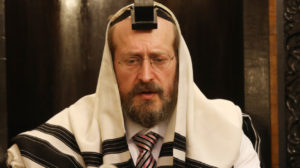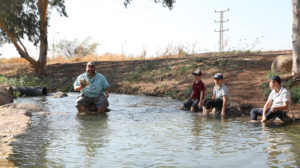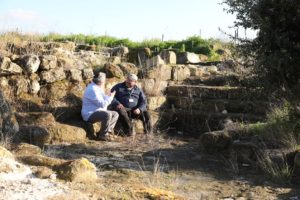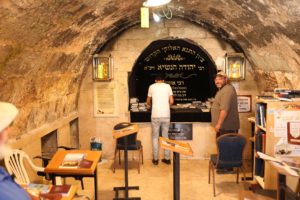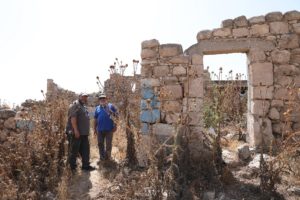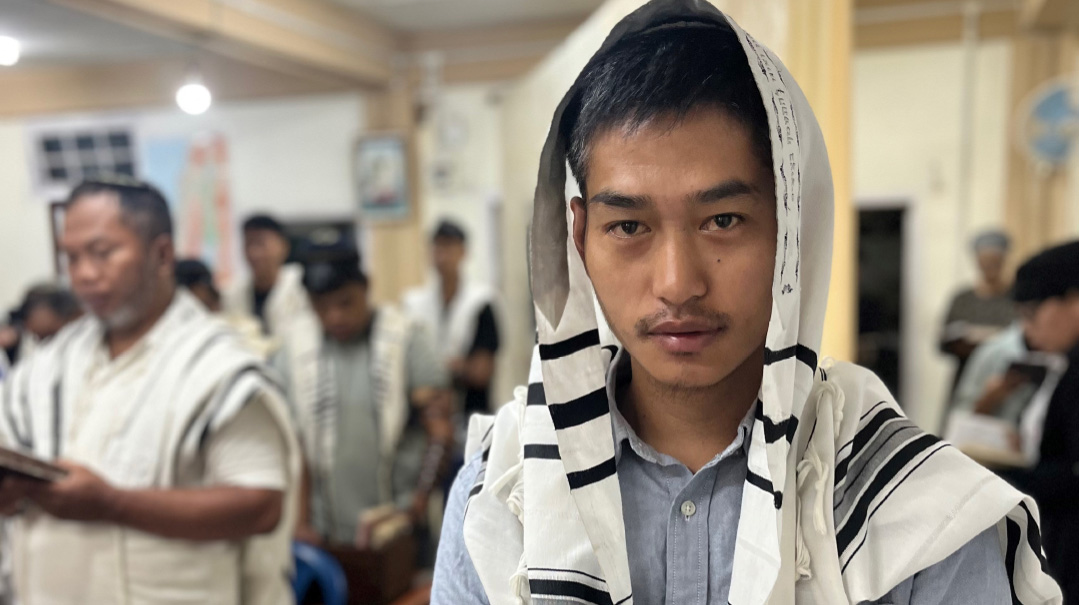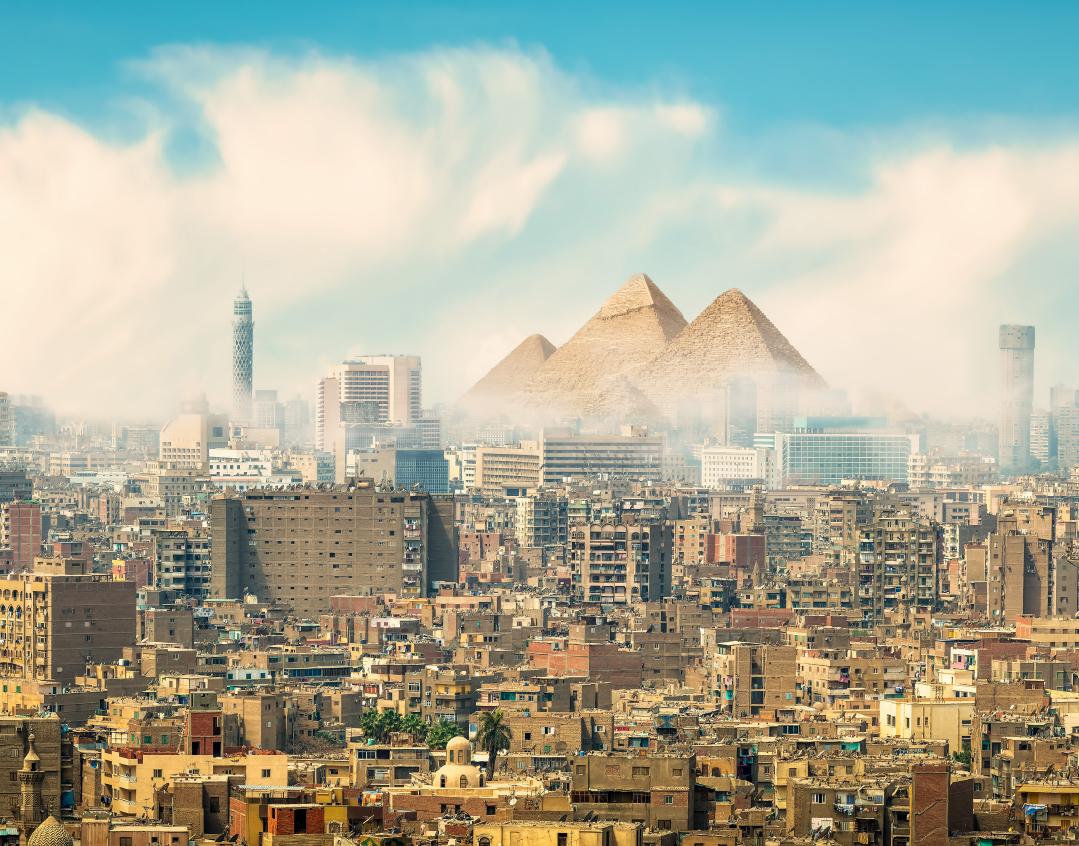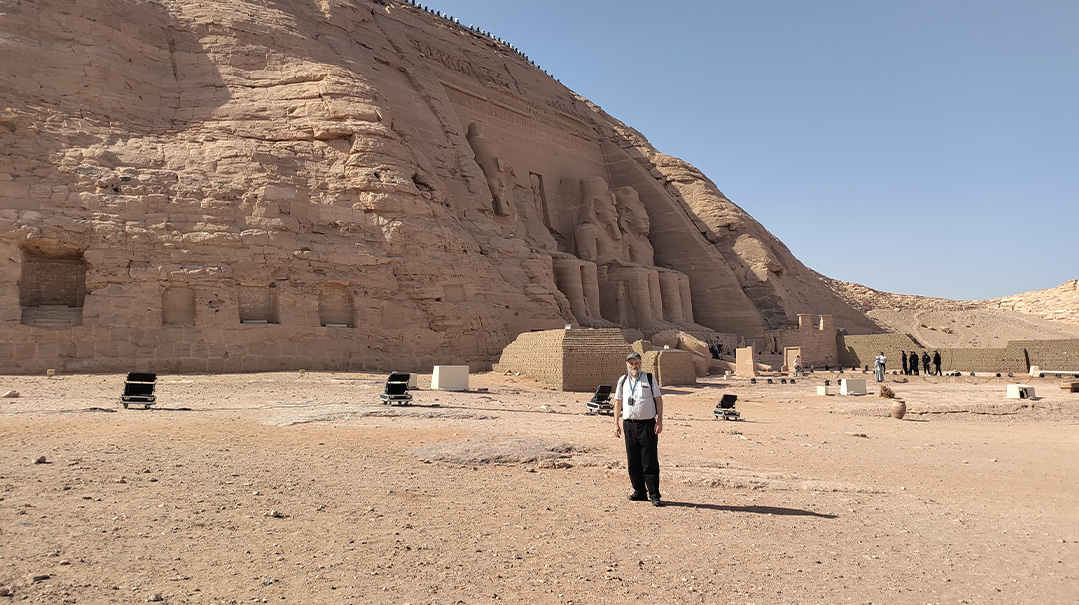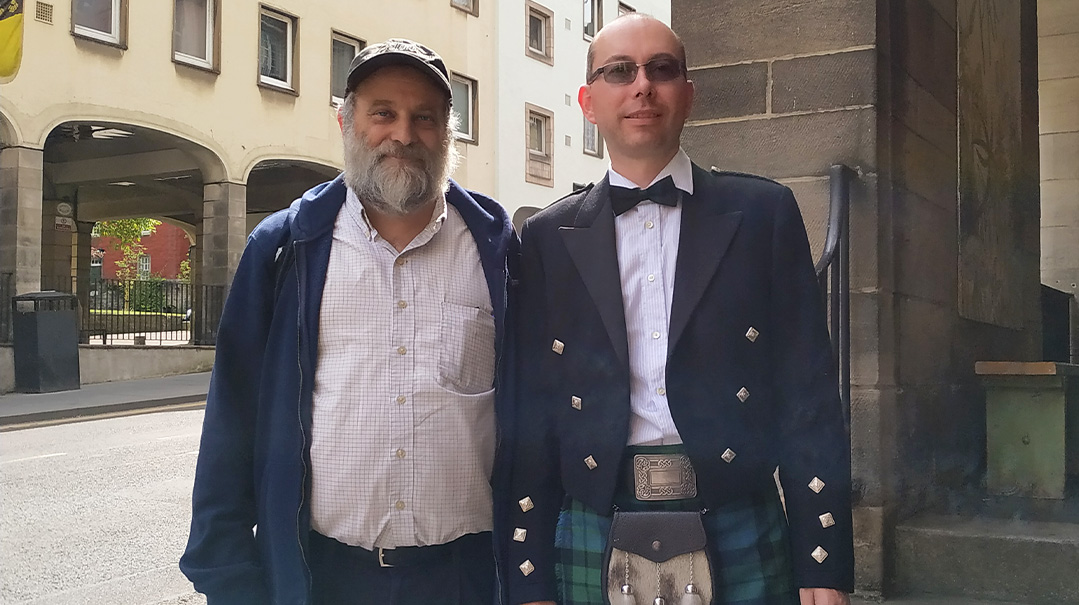Greeting the Ghosts of Salonika
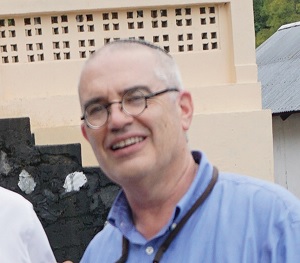
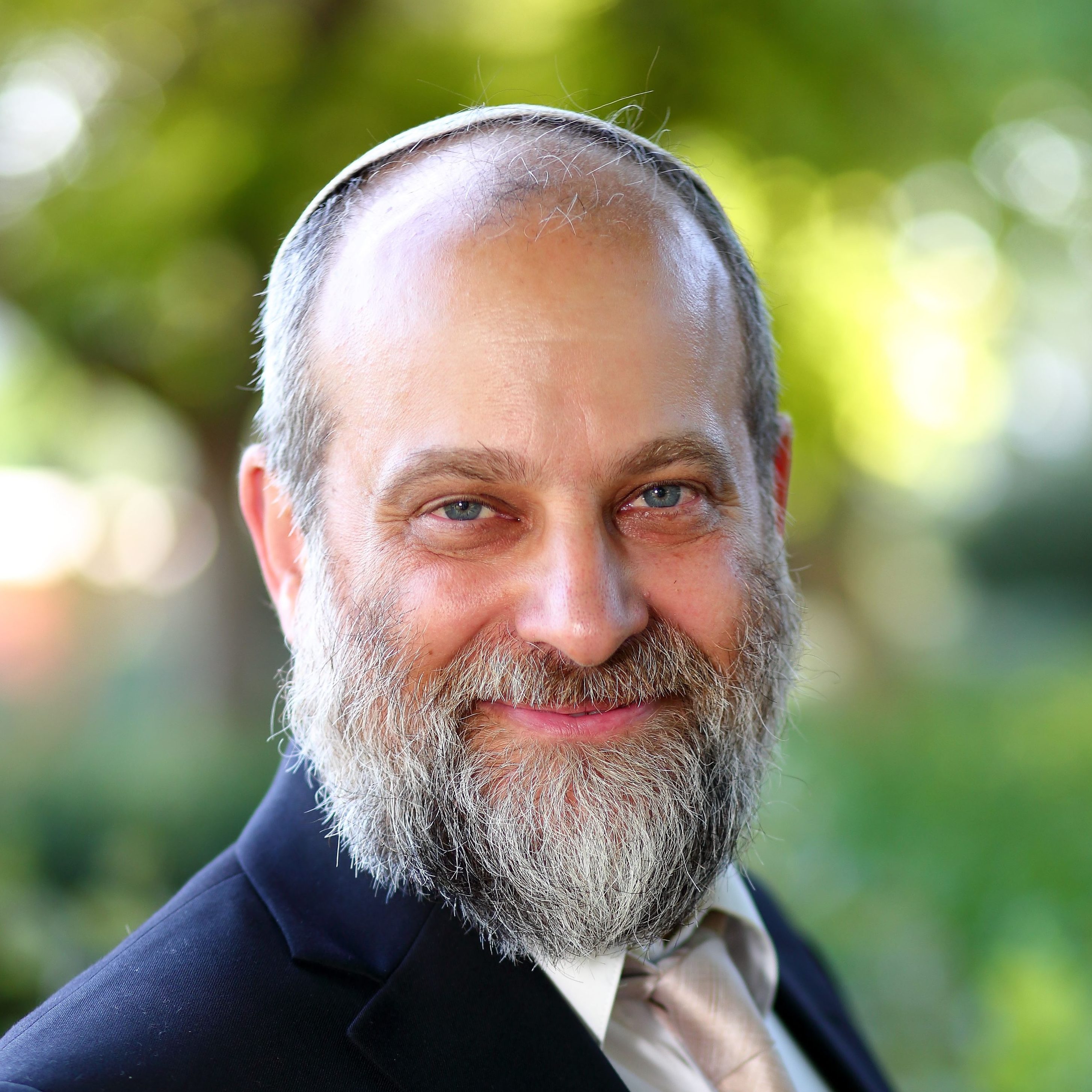

ACTIVE INVOLVEMENT Yad Lezikaron is Salonika’s only active shul. The community pays people to make sure there’s a minyan. The shul is on the ground floor of an eight-story commercial building owned by the community. Often there are community-wide Friday night dinners that attract upward of 100 people (Photos by Ari Z. Zivotofsky and Ari Greenspan)
I t was known as “La Madre de Israel” (the Mother of Israel). And probably the only city of this size and importance in the entire Diaspora that had a Jewish majority. A city in which even the non-Jews had to speak Judeo-Spanish Ladino in order to engage in commerce.
Thessaloniki or Salonika as many know it was one of the most important trading ports on the Mediterranean — and by the early 16th century Jews constituted over 50 percent of the population of this central Greek metropolis. Jews were so dominant that the lifeblood of the city the large port was closed on Shabbos and Jewish holidays.
For over 450 years Salonika was the main center of Jewish Sephardic life and in the early 20th century there were 35 Ladino newspapers in the city. We were told that when the Nazis invaded Greece they were able to recognize some of the Jews by their inability to speak Greek despite their families having lived there for centuries.
We were excited to get a chance to see this ancient community — yet ended up saddened by its utter decline.
Men for a Minyan
The week we visited the local rav Rabbi Aharon Israel — who had been a big help to us in preparing our itinerary — had gone to the countryside with the Jewish camp. His family stayed behind though and when we met his wife and children over Shabbos there was the mandatory Jewish geography surprise: Her sister was visiting from Israel and it turns out their family lives a block away from Ari Z. in Beit Shemesh.
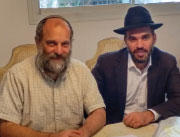
After davening in Yad Lezikaron Salonika’s only active shul. The community pays people to make sure there’s a minyan but they were all on vacation. Together with these men we were able to cobble together a quorum
A substitute rabbi the very learned multilingual Rabbi Yosef Serfaty was there from Belgium. At first we couldn’t understand why another rabbi was needed. Couldn’t the community manage without a religious leader for a week or two? Well the answer is no. Simply put there is nobody who knows the nusach well enough to lead services or how to read the Torah fluently. The community pays ten men to make the minyan so there should always be davening (reminiscent of the Talmud’s ten “batlanim”) but it was our luck that our visit fell during vacation season and they were all away. Between the rabbi ourselves and a few others we eked by with barely a minyan.
“I tried to get five to stay and five to go this week and the same for next week. Why must everyone leave on the same week?” says Regina a vibrant active community member. She and her husband Ino have moved closer to Torah over the last years. For example although Ino had limited formal Jewish education he has taken it upon himself to prepare and lein one aliyah each week. He also serves as the gabbai and both he and his wife come from old Saloniki families who survived the war.
Their daughter lives in Israel and their son is in the family business currently in Cyprus and also with plans to move to Israel. They’ve gone the way of most of the young people — for those few who have stayed it’s hard to find a spouse.
Walking from the shul to our Friday night seudah, our host wore a kippah outside with no discomfort. And when we went out late Motzaei Shabbos to sit along the port with Ino and Regina, we asked them if we should trade our yarmulkes for caps. They said there was no reason to. When we asked the locals about their experience with anti-Semitism, they reported that it was not overt; when somebody found out they were Jewish, they would say, “Really? You don’t look Jewish, tell me it isn’t so.”
During those evening strolls, looking out at the famous harbor and thinking about what it must have been like when the Jews ran this bustling port, the city around us was hopping. We were surprised by the nightlife and the seemingly carefree atmosphere of the large number of people sitting in coffee shops, as the news is full of the financial doom and gloom of the Greek economy.
In conversations we had with locals in various cities on our Greek itinerary, people indeed bemoaned the situation. In Salonika, the unemployment rate is over 25 percent, and among the young, more than twice that. Yet despite the squeeze, the Salonika culture is one of late-night strolls and dining along this famous seaside. Even the poorer Greeks seem to stretch their budget in order to eat out regularly. It seems that no self-respecting Greek would think of starting to dine before nine or ten, and at midnight the place was still lively.
Although Greece was slow to establish diplomatic relations with Israel (the last EU country, in 1991), has always had a serious pro-Arab tilt, and has an underlying anti-Semitic current, the Greek government, unlike many other European governments, willingly gave back the property of heirless Holocaust victims to the Jewish community. Owing to the small number of Jews that returned, this act of the government has helped give the community a measure of financial stability.
Ino and Regina shared with us their own family background, which helped us understand the current makeup of Salonika’s Jewish community. Her family name was Frizi, her background is Romaniote, and she grew up in the city of Chalkis on the island of Euboea, near Athens; the city erected a statue in honor of her great-uncle, who was a war hero. Chalkis has the oldest continuous Jewish population in all of Europe. Their tradition is that they have been there for 2,500 years, since the First Temple period. But both sets of grandparents were the sole survivors of their families, and both her parents were only children, so she has no known relatives.
Ino’s mother and grandmother escaped to the mountains with the partisans after the Nazi invasion, and thus survived the war. His father was the only one of his family to survive Auschwitz. It is easy to understand how this small survivor-based community is mired in the Holocaust.
More Ghosts than People
To appreciate the magnitude of the devastation is to first understand the centrality of this ancient community that, although around for about 2,000 years, saw a population explosion after the Spanish Expulsion in 1492. A census taken in 1478 revealed that there were so few Jews that they weren’t even counted, while there were 4,320 Muslims, 6,094 Greek Orthodox, and some Catholics. But that changed radically. Just 30 years later, there were 7,986 Greek Orthodox, 8,575 Muslims, and 3,770 Jews. By 1519, just nine years after that, there were 15,715 Jews, making up 54 percent of the city’s population.
The situation continued in that vein for the next few hundred years. An 1886 survey found that half of Salonika’s 90,000 to 100,000 inhabitants were Jews. Most of Salonika’s banks and trading houses were in Jewish hands. Travelers to the city in that era were quoted as saying: “Salonika is neither Greek nor Ottoman; it is rather a Jewish city, a sort of Jerusalem.” And, “All the boatmen of the port are Jews, and on Saturdays no steamer can load or discharge cargo. Porters and shoeblacks, bricklayers and silk-hands, are all Jews.”
But it wasn’t just a community of port workers. Salonika was a Torah center for hundreds of years with some of their own minhagim. (One of the more unusual is their observance of two days of Purim, the second day out of a slim possibility that Salonika had been a walled city at the time of Yehoshua bin Nun.
Many of the greatest talmidei chachamim in the Sephardic world found themselves in Salonika at some point. For example, Rav Avraham Hiyya de Boton was born, educated, and taught Torah in Salonika. His name is not familiar to most, but his commentary to the Rambam’s Yad Chazakah, the Lechem Mishneh, is printed in almost every edition of the Rambam. Rav Yosef Karo, author of the Shulchan Aruch, spent several years in Salonika on his way from Toledo, Spain, to Tzfas. While there he was privileged to be taught by a heavenly maggid and recorded those teachings in his work Maggid Meisharim.
One of the biggest scholars, yet mostly unheard of today, was Rav Yosef Taitazak. Known as the Maharitats, he was simultaneously regarded as one of the greatest Talmudists of his time and one of the most mysterious kabbalists of the 16th century. Born in about 1470 in Castille, Spain, he fled in 1492 to Salonika, where for decades he headed the most well-known and important yeshivah in the entire Orient. Among his students were Rav Moshe Alsheich, best known as a Tzfas kabbalist and a commentator on Tanach; Rav Shmuel di Medina, the Rashdam; and Rav Shlomo Alkabetz, the kabbalist who composed Lecha Dodi.
The city was awash in Anusim doctors as well; one of the most famous was Joדo Rodrigues de Castelo Branco, also known as Amatus Lusitanus. He is credited with being the first to discover the function of the heart valves. Unable to return to Portugal after his studies, he moved through Europe, eventually ending up in Salonika.
Centuries later, when future prime minister David Ben-Gurion moved there in 1911 to learn Turkish on his way to study law in Constantinople, he called it “a Jewish city that has no equal in the world” and realized that with its diverse population, it presented an image of how a Jewish state might function.
And even toward the end of its glory days, the city was graced by the presence of a towering chief rabbi. Jerusalem-born Rav Ben-Zion Meir Hai Uziel served as chief rabbi of Salonika from 1921 to 1924 (he would go on to serve as the Sephardic chief rabbi for Mandatory Palestine and the early State of Israel), and he played a part in getting the Jewish community back on its feet immediately after World War I and the devastating 1917 fire that totally destroyed the Jewish quarter.
The centers of commerce were reduced to ashes, and more than 30 synagogues, plus the ancient Jewish library, were obliterated. It was a blow from which the community never fully recovered. The local turmoil before and after the turn of the century led as many as a third of the Jews to emigrate from this greatest of Sephardic cities, many to the new port city of Haifa in Eretz Yisrael, where they established new shuls and communities.
We’ve been to many cities with rich Jewish pasts that are today but a memory, but among the saddest things we’ve seen in all of our travels were the large marble plaques on the walls of the shul in which we davened on Shabbos — lists in Greek and Ladino of all of the synagogues and kehillos that existed in Salonika before World War II.
All but one are gone.
We sat in this modern shul surrounded by these ghosts. During davening, it was hard not to read them over and over again. There were eight plaques with eight shuls on each: That means 64 kehillos were destroyed — congregations such as Eitz Hachaim, which reached all the way back to the first century. This was the small, original Greek community whose shul stood near the port until being destroyed in the 1917 fire.
While people associate Salonika’s Jews with Sephardim because of the influx of Spanish Jewry after the Inquisition (when the kehillos of Aragon, Castille, and old Catalonia were reestablished in this city), there was, in fact, an ancient Ashkenaz shul founded in 1376. In 1391 refugees from the Mallorca riots found refuge here; in 1394 Jews of Provence established a community, and between 1423 and 1430 Italian immigrants opened “Italia Yashan” — so called in comparison to the new Italian synagogue, “Italia Chadash,” founded in 1582.
The pivotal year of 1492 witnessed the establishment of five more congregations: “Spanish Expulsion”; Aragon; Castile, Fisrt Mayor (as in Mallorca); and Old Catalone. After the Portuguese Inquisition was formally requested by King Manuel in 1515, more communities fled to these safe shores and established kehillos such as Lisbon Yashan, Portugal, and Lisbon Chadash.
Today there are only two shuls in Salonika, plus a small synagogue in the old-age home. The thought kept swirling in our heads as we stared at those plaques that the city is more full of ghosts than people.
Survival Shul
One of the extant shuls is the Monastir Synagogue. It was opened in 1927 by families who, following the Balkan Wars and World War I, fled from the ancient community of Monastir, Yugoslavia, known today as Bitola in present-day Macedonia. That community was almost entirely wiped out by the Nazis, but the building itself was spared because it was requisitioned by the Red Cross and used as a warehouse. Of all the synagogue buildings in the city, it was the only one to survive the war more or less intact.
When a few Jews straggled back after the defeat of the Nazis, it became the magnet and the center for Jewish activities —until it was severely damaged in 1978. It took years to repair, but today it is beautifully restored and houses a small Jewish museum mostly devoted to the history of the community. It is used only once a year as a shul — on Yom Kippur.
People are paid by the community to watch and give tours there. When we arrived there were two Jews — a young man and a young woman — giving the tour. We were granted permission to see the sifrei Torah in the aron kodesh, yet when Ari G. started to pull the old silk string to open the paroches, it ripped in his hand.
“It needed to be fixed anyway,” said the girl, easing his embarrassment, although it was an indication that the paroches is rarely opened. Davening might not take place here too often, but the building is used as a venue for special occasions, such as weddings. Both of these young Jews said that their parents were married in that shul and that they too hope to be married there.
The shul with the plaques on the wall and a regular minyan where we davened is named Yad Lezikaron. It was opened in 1984 and as its name implies, it was dedicated to the memory of the victims of the Holocaust. The shul is located near Salonika’s popular Modiano Market (named after a once-prominent Jewish family), and the only kosher meat shop (owned by a religious Turkish immigrant named Shmuel Benson, a regular at the minyan).
Yad Lezikaron was erected on the site of a small shul built in 1912 for the many Jews working in the market who needed a place to daven. The shul is on the ground floor of an eight-story commercial building owned by the community. The top floor has a kosher kitchen and regularly hosts Jewish cultural events. Often, there are community-wide Friday night dinners that attract upwards of 100 people. This kitchen also produces the weekly Seudah Shlishis that’s held in the shul. When we were there, the third Shabbos meal was attended by a modest crowd and consisted of little fare, but was accompanied by an extended derashah on the parshah by the visiting rabbi.
Although the community is doing its best to push forward today, from the mid-1960s until the mid-1990s the kehillah didn’t even have a rabbi. The state of affairs began to change when they hired Rabbi Itzhak Dayan in 1994 (today he’s in Geneva). He built a mikveh, shored up the kashrus standards, instituted a variety of classes including Gemara study, and initiated other activities to re-invigorate religious life. His wife also played a major role by teaching and inspiring the women of the community. Rav Aharon Israel, who has been in Salonika since 2008, has continued these efforts, and today runs an elementary school with over 70 students.
On this island of 1,000 Jews in a sea of a million people, where assimilation and intermarriage are constant threats to survival, there is a concerted effort being made to strengthen this small remnant from within. The community has a school, old-age home, multiple and varied Friday night events, as well as assorted youth programs such as Maccabi basketball — all with an intention of helping Jews connect with Jews and stay within the fold.
Ghetto to Gas Chambers
Salonika as a Jewish center met its devastating end beginning with the German occupation in 1941. At first, the anti-Semitic incidents were “small” — there were a few arrests, the Jews had to surrender their radios, two Jews working for the US consulate were detained and tortured, disease spread, and with the severe famine in the winter of 1942 due to the Nazi destruction of the Greek economy, the death rate rose to 60 a day. But life continued and there was still some illusion of normalcy. For a year, no further anti-Jewish action was taken, which lulled the Jews into a temporary sense of security.
Until “Black Shabbat,” on July 11, Shabbos Mevorchim Av of 1942, when all the men of the community aged 18 to 45 — about 9,000 Jews — were herded into a large plaza called “Freedom Square,” where, for public entertainment, they were subjected to all forms of abuse by the Nazis. Some died, many were left unconscious, and all were beaten. A few days later, 2,000 were sent to forced labor. The Jews tried to negotiate their freedom, and were offered their release for 3.5 billion drachma — a sum way beyond what the community could raise.
Then the Nazis offered to expropriate the cemetery, use the stones for military purposes and count that as 1 billion drachma credit. On Friday, October 16, 1942, the rabbinical council met to consider the offer. They concluded that they could not actively agree to such a condition, but that the Germans could take the cemetery by force. Indeed, the cemetery was taken and the marble was used to line a pool for the troops; local Greeks took stones for their houses, for use in a bathroom of a public school, and for making sidewalks — while the bones lay scattered in open graves. This was an ancient cemetery, possibly dating to Roman times, with over 350,000 Jews interred in it. Today there is nothing left of the cemetery, and the university campus sits atop the Jewish remains.
Soon, five ghettos were formed, including the Baron Hirsch Ghetto, and then between March 15 and May 9 of 1943 a total of 42,830 Salonika Jews were transported to death camps.
Many reasons have been offered for the utter, absolute annihilation of Salonika’s Jews, as opposed to, for example, the Jews of Athens, where fewer than 30 percent were killed. These include the apparent collaboration, or, more likely, the duping of Chief Rabbi Zvi Koretz, who was gullible and ill-informed but apparently not self-serving; the lack of liquid assets with which to bribe and buy false documents; the difficulty in hiding Jewish identities because they did not speak Greek; the devotion to family, wherein young people would not abandon parents in order to seek safety; and help with the deportations by the local Greek population.
While there certainly were righteous individuals —including Archbishop Damaskinos, head of the Greek church during the Nazi occupation, who ordered all churches and monasteries to give the Jews refuge, who personally saved Rabbi Elia Barzilai, and who was the only head of a European church to officially demand that the Germans stop the deportations — the Greek Orthodox Church, the most dominant institution in Greece, is anti-Semitic at its core and was instrumental in fomenting cooperation with the Nazis.
Staying Afloat
The city finally built a Holocaust memorial in 1997, and in 2005 it was moved to Freedom Square, just opposite the port in a swanky part of town where the Jews once controlled the financial center and where the first roundup took place. Indeed, the current mayor of Salonika, Yiannis Boutaris, wore a yellow patch at his recent inauguration as a statement against the powerful neo-Nazi Golden Dawn party. He has so far been instrumental in raising $20 million toward building a Jewish cultural center that will focus on the 500 years the community thrived, and not just on its tragic end.
Salonika was a historical haven for Jews, who prospered here both spiritually and materially for over five centuries. The remaining Jewish residents of this important port city are keenly aware of their rich history, and with their limited resources and knowledge, are doing their best to buck the tide, right the ship, and keep the Jewish presence in Salonika afloat.
(Originally featured in Mishpacha, Issue 673)
Oops! We could not locate your form.

